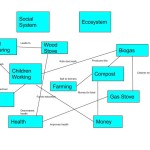My diagram starts out with the process of wood gathering. In order to wood gather, you must have someone to do it. That responsibility in the village falls mostly on the children. Since the children spend most of their time wood gathering, there is not a lot of time for their studies. This will put the children in the same position as their parents since they will not be educated. Another problem is a wood stove burns the wood. A burning wooden stove puts off smoke. If there is a constant amount of smoke in the house, your health will deteriorate. Changing your energy source to biogas can solve this problem. Biogas is a clean alternative to wood burning. This is because you can have a gas powered stove instead of a wood burning one. There will not be smoke to pollute the house unlike the wood stove. Children also do not have to gather wood. Instead they can spend this time improving their studies. The biogas also has a byproduct of compost. The compost can be collected and sold to farmers to earn extra money to buy food or further educate children. This biogas brings stability to a home because they will always have fuel. My diagram is similar to Gerry Marten’s because we both talk about cooking fuel in our diagrams. They are different because he uses irrigation water in his. There are similarities and differences because we each view things differently. What can be learned from the diagrams is that biogas ties it all together
3 thoughts on “Module 2: Biogas”
Leave a Reply
You must be logged in to post a comment.


Hi Ryan, great job on your post. I like the focus that you put on the children in this situation. The video said they spend considerable time collecting firewood without the biogas. Also, I like how you mentioned that the biogas generator gives the system stability because the gas is dependable and renewable. I wonder what the total benefit there is from these kids being able to focus on school and if that has a large benefit later on.
Very similar to my post: http://geog030.dutton.psu.edu/2016/01/27/42672/
Hey Ryan, this is Rob Hudert here. It is interesting to see the differing perspective taken between you and I when making the diagram. You decided to start with a problem, whether the wood collection or the burning of wood and classify them as an ecosystem problem or a social system problem and then building out from there. I on the other hand choose to start with the biogas generator and systemically build out how each step impacts the next in the sequence of events, whether socially or environmentally. This shows as we have certain things on our charts such as money on opposite sides. You also included things like school while I had the intention of that being included under the realm of increased well-being.
Link: http://sites.psu.edu/geog30/2016/01/27/rob-hudert-bio…system-diagram/
Hey Ryan, I enjoyed reading your article and found it fairly similar to my own article. One thing that the two of our diagrams share in common is the fact there was a high demand for a cleaner fuel. You talk about it in your article with the problems of the smoke from the wood, and the time required to collect the wood. This demand for change sparked the need for innovation, which led to the invention of the biogas plant. I also liked how your diagram shows two different paths to the “Health” box. One path shows how health is hurt, and the other shows how it is increased. I discussed similar topics in my post which can be read using the link below.
http://geog030.dutton.psu.edu/2016/01/24/william-graf-module-2/